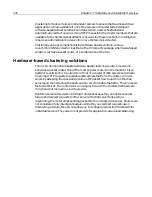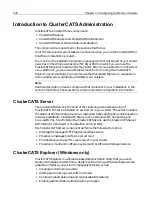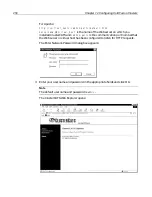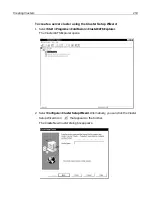
240
Chapter 11 Scalability and Availability Overview
Clustering for failover relies on redundant servers to ensure that business-critical
applications remain available if one of the servers in a cluster fails. Intelligent
software-based failover solutions can detect when a server has failed and
automatically redirect new incoming HTTP requests to the cluster members that are
available. Some hardware-based failover devices that have less built-in intelligence
require an administrator’s intervention once the failure is detected.
Clustering can be accomplished using software-based solutions, such as
round-robin DNS by itself or together with a third-party package, a hardware-based
solution, such as a packet router, or a combination of the two.
Hardware-based clustering solutions
The most common and reliable hardware-based clustering solution is a device
known as a packet router. One of the most popular routers on the market is Cisco
System’s LocalDirector. A router sits in front of a cluster of Web servers and directs
incoming HTTP requests to available Web servers that form the cluster. A router
works by assessing the speed and volume of IP packet flow to and from the Web
servers and then selecting the best server to accommodate the traffic. This process is
fast and efficient. The router device in conjunction with the clustered Web servers
comprise what is known as a virtual server.
Routers are considered semi-intelligent devices because they can detect a server
failure and redirect requests to other servers. If a Web server fails or stops
responding, the router stops sending packets to the unresponsive server. Routers are
not considered fully intelligent because while they can redirect requests upon
discovering a failure, they do not allow you to configure redirection thresholds for
individual servers. They also do not provide for application-aware load balancing.
Summary of Contents for COLDFUSION 5-ADVANCED ADMINISTRATION
Page 1: ...Macromedia Incorporated Advanced ColdFusion Administration ColdFusion 5...
Page 20: ......
Page 56: ...38 Chapter 1 Advanced Data Source Management...
Page 74: ...56 Chapter 2 Administrator Tools...
Page 76: ......
Page 86: ...68 Chapter 3 ColdFusion Security...
Page 87: ...To Learn More About Security 69...
Page 88: ...70 Chapter 3 ColdFusion Security...
Page 130: ...112 Chapter 5 Configuring Advanced Security...
Page 132: ......
Page 154: ...136 Chapter 6 Configuring Verity K2 Server...
Page 162: ...144 Chapter 7 Indexing XML Documents...
Page 202: ...184 Chapter 8 Verity Spider...
Page 236: ...218 Chapter 10 Verity Troubleshooting Utilities...
Page 238: ......
Page 348: ...330 Chapter 14 ClusterCATS Utilities...
Page 349: ...Using sniff 331...
Page 350: ...332 Chapter 14 ClusterCATS Utilities...
Page 362: ...344 Chapter 15 Optimizing ClusterCATS...
Page 372: ...354 Index...
















































